| Rob: | (dialogue) |
| Miho: | (dialogue) |
| Rob: | (dialogue) |
| Miho: | (dialogue) |
| Rob: | (dialogue) |
| Miho: | (dialogue) |
| Rob: | (dialogue) |
| Miho: | (dialogue) |
| Rob: | (dialogue) |
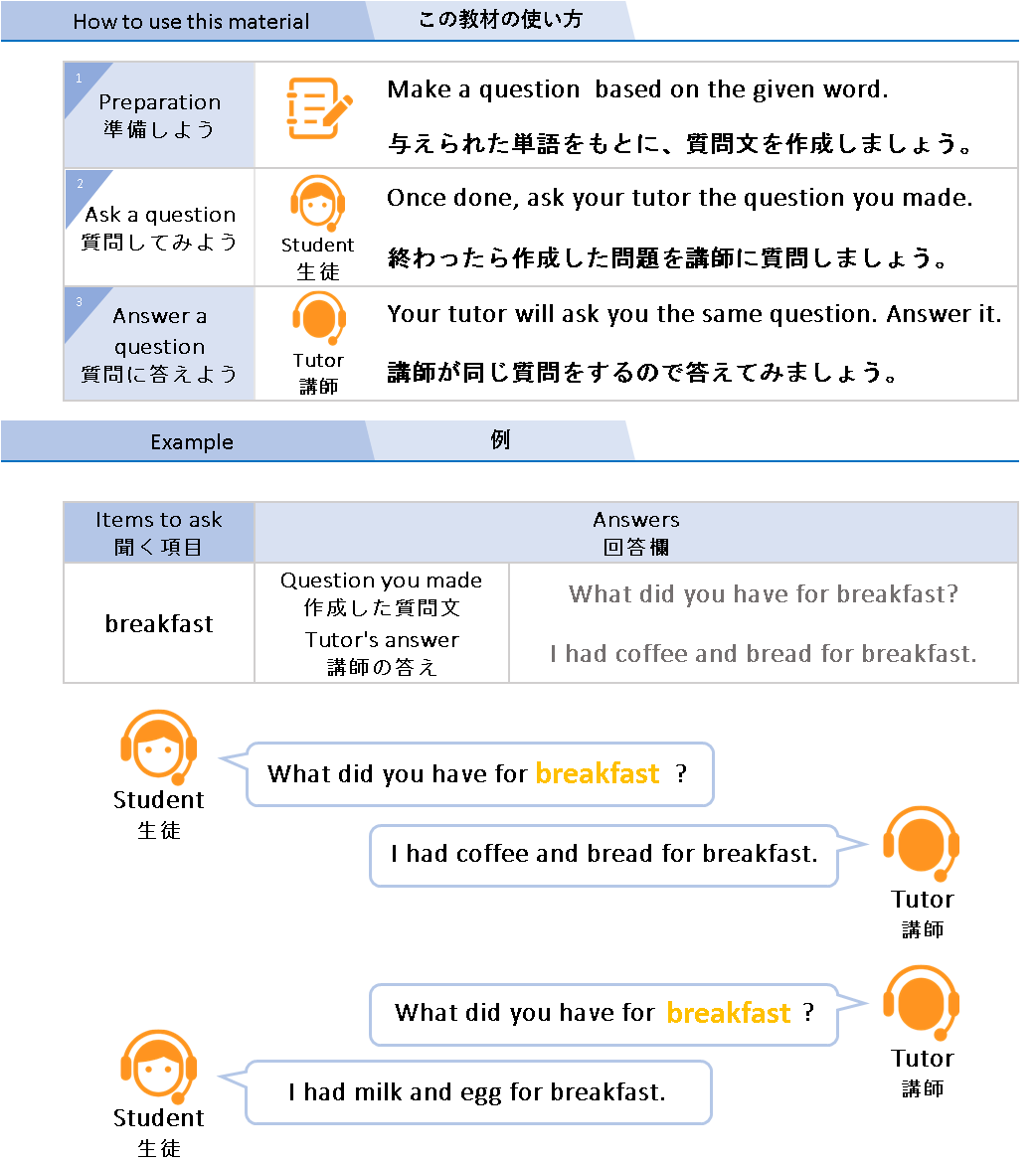
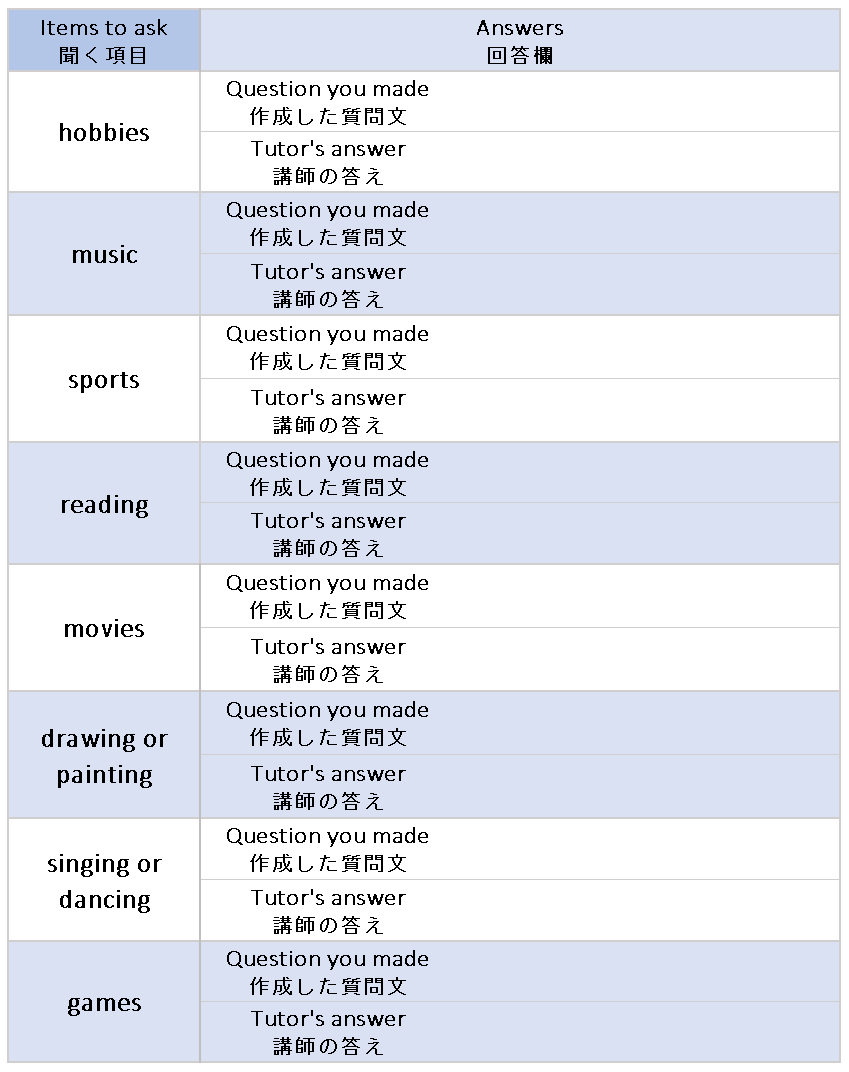
| Rob: | (dialogue) |
| Miho: | (dialogue) |
| Rob: | (dialogue) |
| Miho: | (dialogue) |
| Rob: | (dialogue) |
| Miho: | (dialogue) |
| Rob: | (dialogue) |
| Miho: | (dialogue) |
| Rob: | (dialogue) |


1. What is your name?
2.
3.
4.
5.
My tutor’s name is _____________________.
__________________________________________.
__________________________________________.
__________________________________________.
__________________________________________.
| Alex: | |
| Bill: | |
| Alex: | |
| Bill: | |
| Alex: | |
| Bill: | |
| Alex: | |
| Bill: |
1.
Answer: ______________________________________________________________
2.
Answer: ______________________________________________________________
3.
Answer: ______________________________________________________________
| 1. | Tutor: |
| Student: | |
| Tutor: | |
| Student: _______________________________ | |
| a. b. c. d. |
| 2. | Tutor: |
| Student: | |
| Tutor: | |
| Student: _______________________________ | |
| a. b. c. d. |
| 3. | Tutor: |
| Student: | |
| Tutor: | |
| Student: _______________________________ | |
| a. b. c. d. |
| 4. | Tutor: |
| Student: | |
| Tutor: | |
| Student: _______________________________ | |
| a. b. c. d. |
| 5. | Tutor: |
| Student: | |
| Tutor: | |
| Student: _______________________________ | |
| a. b. c. d. |
| Situation: | Your tutor will pretend as (character). You will ask your tutor questions about (topic). |
| Items to mention: | – – – – – – – |
Read the passage silently for 20 seconds. Then, read the passage aloud in 1 minute starting from the title.
Restaurants
Nowadays, eating at a restaurant has been popular. People choose to eat at a restaurant than to eat at home. Some people do not have time to cook, so they choose to eat at a restaurant.
Please look at the passage.
Why do some people choose to eat at a restaurant?
Please study the picture below.
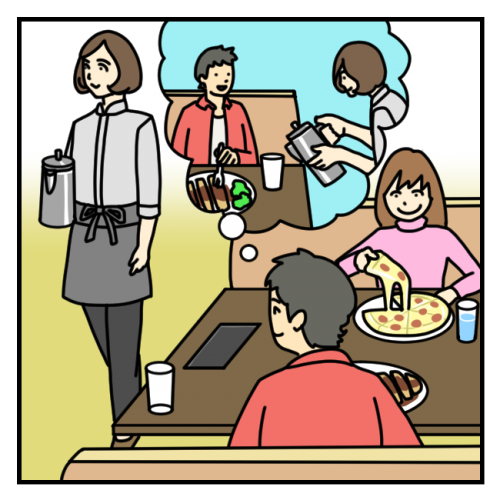
Please look at the picture.
How many glasses are on the table?
Please look at the man.
What is he going to do?
What kinds of food do you not like eating?
Do you cook your own meals?
If yes → Please tell me your favorite dish to cook.
If no →
Why do some people buy flowers on special days?
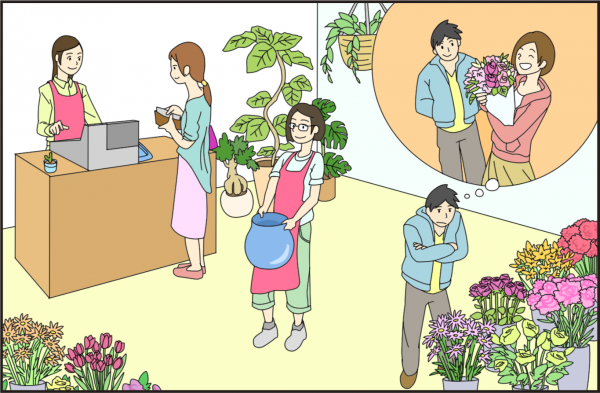
How many customers are there in the picture?
What is he going to do?
Read the passage silently for 20 seconds. Then, read the passage aloud in 1 minute starting from the title.
Family Day
Sunday is a day for rest. It is a day for families to do fun activities together. Many people choose to spend time with their families during that day, so they have Sunday as their family day.
Please look at the passage.
Why do many people have Sunday as their family day?
Please study the picture below.
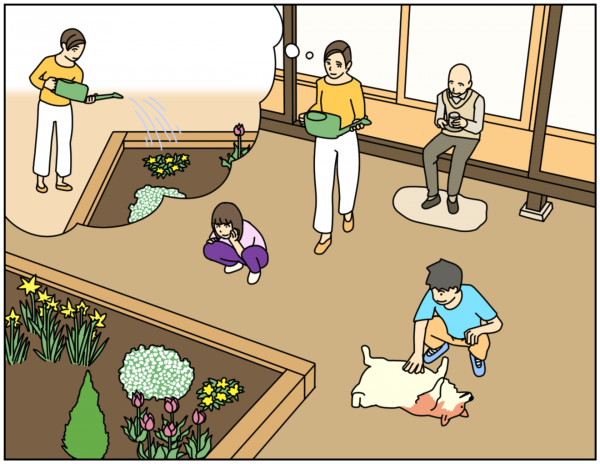
Please look at the picture.
What is the boy doing?
Please look at the woman with short hair.
What is she going to do?
What is your favorite part of your house?
Do you grow fruits or vegetables in your garden?
If yes → Please tell me more.
If no →
| 1. | What is your name? |
| 2. | Is there a mall in your city? |
| 3. | What is the nearest train station to your house? |
| 4. | How do you go to the nearest train station? |
| 5. | Is there a supermarket near your house? |
| My tutor’s name is | |
| Alex: | Bill, I can’t find the movie theater. Can you help me? |
| Bill: | Sure. But you must hurry. All movies are going to start in 10 minutes. |
| Alex: | I see. Can you tell me the fastest way to go there? |
| Bill: | The movie theater is located on the fourth floor of the new building. |
| Alex: | I didn’t know there’s a new building around here. How do I get there? |
| Bill: | Take the escalator, and turn left once you reached the second floor. When you see a doughnut shop, turn right. Walk straight until you see the entrance of the new building. |
| Alex: | Great! Thank you so much. |
| Bill: | No problem. |
| 1. | Where is Alex going? |
| Answer: | |
| 2. | Where is the movie theater located? |
| Answer: | |
| 3. | How to get to the new building? |
| Answer: |
(Note to tutor: Please find the answer key in the last page.)
| 1. | Tutor: | I will go to the art museum today. Would you like to go with me? | |
| Student: | I’d love to. But, I don’t know how to get there. | ||
| Tutor: | I know the way. Do you want to meet me at the train station? | ||
| Student: |
| a. | That place is amazing! | ||
| b. | Yes. See you there. | ||
| c. | I can’t. It’s too far. | ||
| d. | It’s famous. |
| 2. | Tutor: | Do you know where I can find the nearest bank? |
| Student: | Yes. It’s just beside the city hall. The city hall is only a few minutes’ walk away. | |
| Tutor: | Is it open today? | |
| Student: |
| a. | Banks are closed today. | ||
| b. | The waiting line outside is long. | ||
| c. | Yes. It’s just a walking distance. | ||
| d. | It can’t be. |
| 3. | Tutor: | Excuse me. May I ask how to get to the train station? |
| Student: | Sure. Are you going to take a taxi or a bus? | |
| Tutor: | I was planning to take a taxi from here. What should I tell the driver? | |
| Student: |
| a. | Tell him to drop you off at Kingston Road. | ||
| b. | You can’t. The traffic is heavy. | ||
| c. | The train station will close in ten minutes. | ||
| d. | I will check later. |
| 4. | Tutor: | I will visit you at the hospital tomorrow. How do I get there? |
| Student: | Are you taking a bus or a taxi? | |
| Tutor: | I’m not sure. Which one is the fastest way? | |
| Student: |
| a. | I’m not available tomorrow. Sorry. | ||
| b. | You can take either of them. | ||
| c. | There are no alternative routes to get here. | ||
| d. | I don’t think so. |
| 5. | Tutor: | How far is the nearest hotel from here? |
| Student: | It’s about eight miles away. Why? | |
| Tutor: | I’m looking for a room where I can stay overnight. How many minutes will it take for me to get there? | |
| Student: |
| a. | The nearest hotel stopped operating last year. | ||
| b. | It’ll take at least 15 minutes for you to get there. | ||
| c. | I’d always wanted to have an overnight stay at a beach resort. | ||
| d. | Resorts are not good. |
| Situation: | Your tutor will pretend as an airport staff. You will ask your tutor questions about directions. |
||||||||||||||||||||||||||||||||||||||||||||||||||||||
| Items to mention: |
| – where is Paradise hotel | ||
| – how to get there | ||
| – travel time | ||
| – how far | ||
| – nearest supermarket from Paradise hotel | ||
| – nearest sightseeing spot from Paradise hotel | ||
| – how to go back to airport from the hotel |
| 1. | b |
| 2. | a |
| 3. | a |
| 4. | b |
| 5. | b |
Means of travel
The most common means of travel are flying on an airplane or sailing on a ship. There are a few things to consider when choosing between the two. One is the travel time. Traveling by plane takes only a few hours, while traveling by ship may take a few days depending on the destination. The ticket price also varies. Air travel can be more expensive than sea travel. Passengers may choose depending on their preferences and whichever is more comfortable for them.
1. What are the most common means of travel?
Answer: ______________________________________________________________
2. How long does it take to travel by plane?
Answer: ______________________________________________________________
3. Which is more expensive, air travel or sea travel?
Answer: ______________________________________________________________
| Words and Expressions | Sample Sentences |
| sail | _______________________________________________ |
| destination | _______________________________________________ |
| passenger | _______________________________________________ |
| preference | _______________________________________________ |
| comfortable | _______________________________________________ |
1. Why do some people like traveling?
Answer: ______________________________________________________________
2. Do you think it’s better to travel abroad than in your own country?
Answer: ______________________________________________________________
3. Do you think it’s necessary to spend a lot of money in order to travel comfortably?
Answer: ______________________________________________________________
4. What do you think is the safest means of travel?
Answer: ______________________________________________________________
5. Why do you think some people prefer to travel by plane?
Answer: ______________________________________________________________
6. Which do you prefer, traveling by ship or plane?
Answer: ______________________________________________________________
7. Do you think spending long hours to travel is a waste of time?
Answer: ______________________________________________________________
There are a lot of reasons as to why people love to travel. Some people want to explore, learn about other cultures, appreciate the beauty of different places, and some just want to relax and have fun. Most people say that they feel happier ever since they started traveling.
One of the most visited places around the world is Hong Kong. Some tourists fly all the way to Asia from America or Europe just to visit the country. There are a lot of things to do in the country. Tourists can go to Victoria Peak or ride the Star Ferry and fall in love with the wonderful views of nature. People can also visit the country’s beautiful theme parks and shops in one of the cheapest street markets in the world.
1. What are the reasons why people love to travel?
Answer: ______________________________________________________________
2. What is one of the most visited places around the world?
Answer: ______________________________________________________________
3. What can tourists do in Hong Kong?
Answer: ______________________________________________________________
| Words and Expressions | Sample Sentences |
| explore | _______________________________________________ |
| beauty | _______________________________________________ |
| ever since | _______________________________________________ |
| all the way to | _______________________________________________ |
| fall in love with | _______________________________________________ |
1. What do you think is the main reason why people travel?
Answer: ______________________________________________________________
2. What do you think is the best country to visit?
Answer: ______________________________________________________________
3. Do you think spending money on traveling is worth it?
Answer: ______________________________________________________________
4. How would you describe a great trip?
Answer: ______________________________________________________________
5. Do you think having tourists visit your country is a good thing?
Answer: ______________________________________________________________
6. What can you say about those people who prefer traveling abroad to traveling in their own country?
Answer: ______________________________________________________________
7. Do you think it’s better to travel alone than with other people?
Answer: ______________________________________________________________
In this lesson, you will practice reading passages and answering questions.
Please read the passage below silently for 20 seconds.
Then, please read aloud the passage starting from the title.
I will correct your pronunciation as you read.
Breakfast
People need to eat breakfast every morning. People often eat bread and drink milk for breakfast. Breakfast gets people ready for the day so, eating breakfast every morning is important.
Please look at the passage. Why is eating breakfast important?
Please read the passage below silently for 20 seconds.
Then, please read aloud the passage starting from the title.
I will correct your pronunciation as you read.
Friends
Most people like to have many friends. They go to the park, eat together, and watch movies with their friends. They enjoy doing fun things together, so most people like to have many friends.
Please look at the passage. Why do most people like to have many friends?
Please read the passage below silently for 20 seconds.
Then, please read aloud the passage starting from the title.
I will correct your pronunciation as you read.
Traveling
Many people like to travel with their family and friends. They like going to beautiful places and eating good food. Some people want to remember their travel, so they take nice pictures.
Please look at the passage. Why do some people take nice pictures?
Please read the passage below silently for 20 seconds.
Then, please read aloud the passage starting from the title.
I will correct your pronunciation as you read.
Fruits
Many people like to eat fruits like mangoes, melons and bananas. They often eat fruits after meals. Eating fruits is good for the body, so many people like to eat fruits.
Please look at the passage. Why do many people like to eat fruits?
Please read the passage below silently for 20 seconds.
Then, please read aloud the passage starting from the title.
I will correct your pronunciation as you read.
Books
Many people enjoy reading books. There are many books about different subjects. Some people learn new things by reading books, so they enjoy reading books in their free time.
Please look at the passage. Why do some people enjoy reading books in their free time?
Please read the passage below silently for 20 seconds.
Then, please read aloud the passage starting from the title.
I will correct your pronunciation as you read.
Mobile Phones
Many people use their mobile phones often. They can talk to their family and friends using their mobile phones. They need to talk to other people often, so mobile phones are important for some people.
Please look at the passage. Why are mobile phones important for some people?
Please read the passage below silently for 20 seconds.
Then, please read aloud the passage starting from the title.
I will correct your pronunciation as you read.
Garden
Some people like gardening. They plant different flowers and trees near their houses. Flowers and trees make their houses look more beautiful, so some people like to have a garden.
Please look at the passage. Why do some people like to have a garden?
Please read aloud the following passage. I will check your pronunciation as you read.

Sam will stay at Hanami hotel during his trip. But he does not know how to get there. He asked an airport staff for directions. The airport staff said that he may take the train and get off at Shibuya Station. She also said that he may walk from the train station to the hotel or take a taxi.
Please answer the following questions based on the passage.
1. Where will Sam stay during his trip?
Answer:_______________________________________________
2. At what station should Sam get off?
Answer:_______________________________________________
3. Does Sam need to take a bus?
Answer:_______________________________________________
Describe the picture using the following expressions:
”across”
“…next to…”
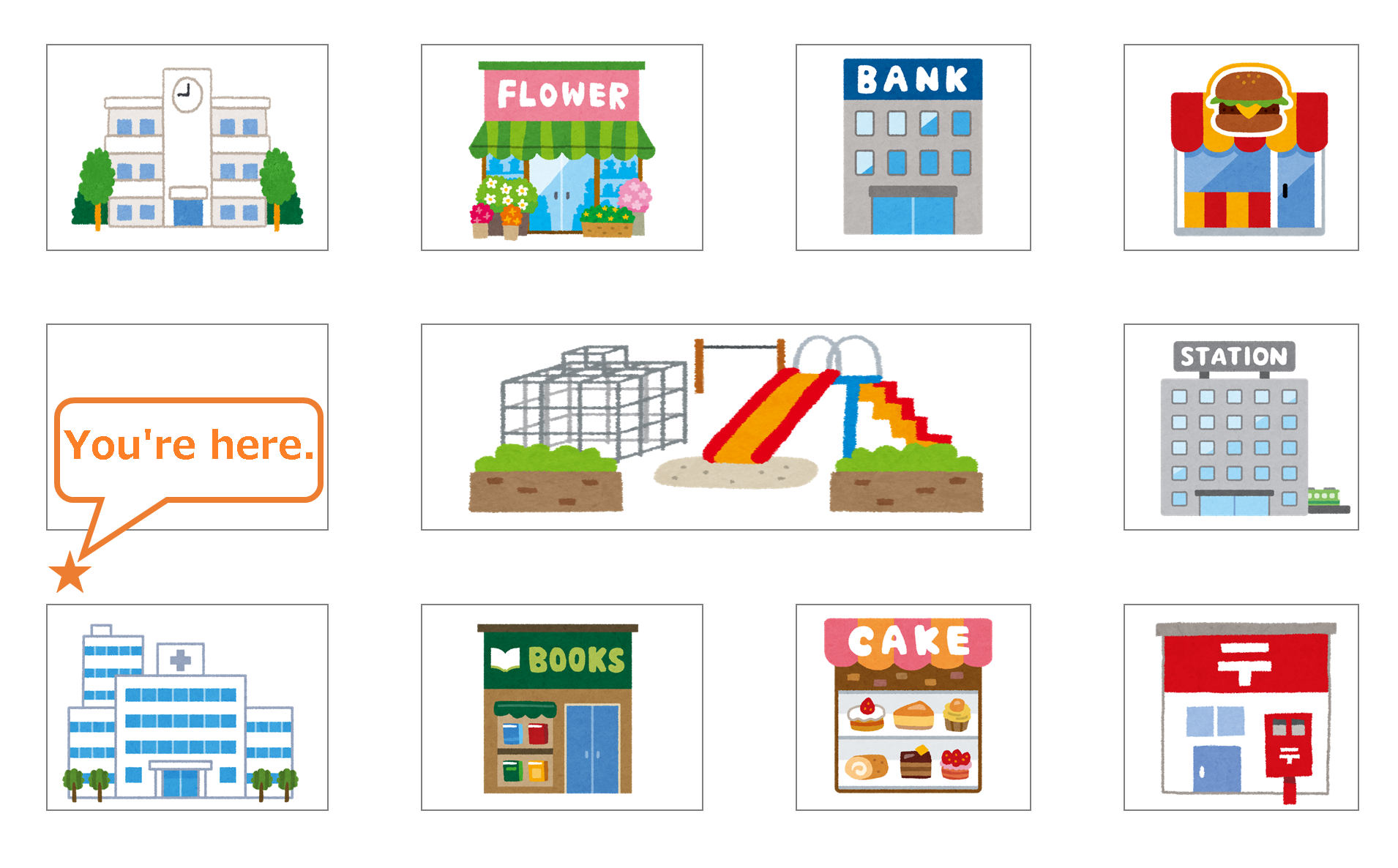
Please answer the following questions based on the picture.
1. Could you tell me the way to the station?
Answer:_______________________________________________
2. Could you tell me the way to the bank?
Answer:_______________________________________________
3. Could you tell me the way to the flower shop?
Answer:_______________________________________________
Please answer the following questions based on your experience.
1. How do you get to school every day?
Answer:_______________________________________________
2. How long is your travel time?
Answer:_______________________________________________
3. Is the library near your classroom?
Answer:_______________________________________________
4. Is the school clinic next to the cafeteria?
Answer:_______________________________________________
5. How do you get to the supermarket from your home?
Answer:_______________________________________________